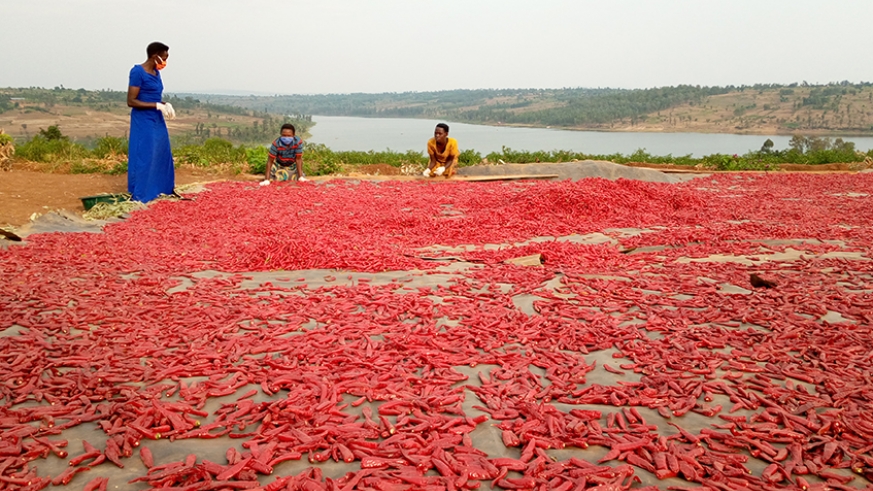The growing global appetite for Rwandan chili has led to an upsurge in the number of farmers investing heavily in cultivating the crop, mainly in Bugesera District.
After learning of the growing chili market two years ago, Pascal Mulindwa, 39, ditched other vegetables that he was growing to exclusively concentrate on chili.
Today, he exports the produce to India.
“Bugesera is a dry area and you cannot invest in an irrigation facility to irrigate beans because you will get profit going by how the crop performs on the market. But if you invest in irrigation of crops like chili, there is no doubt you will get good income,” he said.
The father of four has two separate plantations covering six hectares near the shores of Lake Kidogo, located in villages in Bugesera District.
Pelagie Kabano, chili farmer in Ngeruka, Bugesera District (Courtesy)
“In farming, when you have market, and you have the capacity to withstand climate change, you undoubtedly make profit,” he noted.
The first season he planted on two hectares and earned Rwf3 million, he expects about Rwf20 million this season.
Mulindwa did agronomy in secondary school, and in university he pursued law; he said the two qualifications help his farming profession and negotiating contracts, respectively.
Pélagie Kabano, a 40-year-old mother of five who grows chili on eight hectares on the shores of Lake Cyohoha, said, “I started because I found a market.”
Kabano used to grow onions and other subsistent crops like beans, but now she got market in India for the chili that she is currently harvesting, drying and preparing for export.
Following 2018 season loss and 2019 season that brought her a “fair” profit on two hectare plantation, the said she expects much better yield this time, after investing more money, time and efforts in the crop, and expanding from two to eight hectares.
Pascal Mulindwa collecting chili from his farm (Courtesy)
Kabano said she has learned that “farming takes patience” and expects to harvest more than 15 tonnes, with the buyer paying $1.2 a kilo.
“To all women, any profession you love doing, you should do it, I love agriculture, the love for it has given me the courage to pursue it, even if I lose once, I say ‘let me keep trying until I get where I want to be,’” she advised.
Mulindwa and Kabano are among the farmers who benefitted from Rwanda’s plan to promote horticulture and other cash crops like tea, coffee, sericulture since 2012 through Project for Rural Income through Exports (PRICE).
Implemented by National Agricultural Export Development Board (NAEB) and funded by International Fund for Agricultural Development (IFAD), PRICE is where Mulindwa got the opportunity to expand his farming from two to six hectares using Rwf15 million, a half being a loan and the other half a grant.
Kabano received Rwf17 million which helped her to expand from two to eight hectares.
From sales from the current harvest season, the two farmers expect enough income to expand once again on their own.
Bugesera has nine lakes and two big rivers_ Akanyaru and Akagera. Sunshine is seen as opportunity when irrigation is available. (Photo_ JD Nsabimana)
The urge to expand for Mulindwa is caused by the fact that he has a very big demand that he cannot satisfy it, he also collects chili produce from other farmers to sell it using his contract.
“In January, there is another farmer who has 10 hectares and will grow chili and sell it through my contract. There are also other friends who have four hectares and are planning to join me,” he declared.
Jean Damascène Sijyenibo, Director of Agriculture and Natural Resources at Bugesera District, told The New Times that sunshine and many water bodies allow horticulture in the marshlands in the district often devastated by drought.
Bugesera has nine lakes and two big rivers; Akanyaru and Akagera, and Sijyenibo said sunshine is seen as an opportunity when irrigation is available.
Ninety per cent of chili farmers in Bugesera already have market, and the rest 10 per cent are able to sell through those who have contracts.
This crop is only for export, and no farmer has grown chili and sold it locally, Sijyenibo said, adding that so far, market is readily available abroad.
